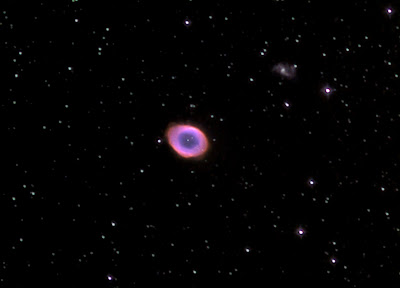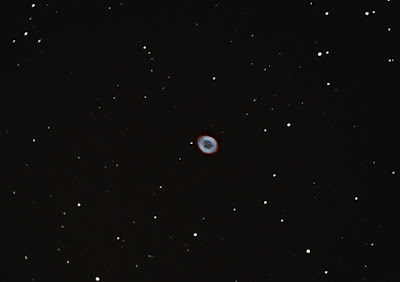
June 8th, 2004 presented a once-in-several lifetimes opportunity to witness a Venus solar transit. They occur in pairs, 8 years apart, with 122 years between the second of one series and the first of the next. The next one is due on June 5th. 2012, but occurs after sunset in the UK and so won't be visible unless you go to Japan or somewhere like that.
Historically, these events were of tremendous importance, with accurate timings being used to try and calculate the distance of the Earth from the Sun. In his book Venus, (2002, Cassell Illustrated, ISBN 0 304 36281 6) Patrick Moore gives a fascinating account of the various travels and travails that early observers went to to witness these events. These days, they are observed more for fun rather than for any scientific purpose.
For my own part, I fitted my Vixen ED114SS with a Baader solar film filter and used a digital camera held up to the eyepiece to take the various shots shown here. The Baader film gives a white light image and I added a yellow mask in Paint Shop Pro to make them look pretty, but other than rotating or cropping, not much processing was needed to clean up the images I gathered.
The image above is a combination of shots taken roughly every hour, from around 6.30 to 12.15 BST, with the camera held up to a 25mm eyepiece. Two tiny sun-spots can be seen in the centre of the Sun's disc (which made job of the aligning the layers for the composite frame a lot easier!)
The sequences below used a 9mm eyepiece.
 The sequence above shows the contact of the western and then eastern limbs of Venus with the eastern limb of the Sun. The two frames just before second contact clearly show the dense Venusian atmosphere lit up from behind by the Sun's glare.
The sequence above shows the contact of the western and then eastern limbs of Venus with the eastern limb of the Sun. The two frames just before second contact clearly show the dense Venusian atmosphere lit up from behind by the Sun's glare.
Similarly, the second sequence above shows the contact of the western and then eastern limbs of Venus with the western limb of the Sun. Again, the two frames just after third contact show the Venusian atmosphere lit up from behind by the Sun's glare, although not as clearly as at second contact. By then, a high haze had set in, diminishing visibility.
However, both the weather and the actual timings were kind to observers in my south-east corner of the UK, and I was able to witness the whole event. Observers from other locations weren't so lucky.
Because my eastern horizon is a bit cluttered from where I normally observe, early that morning I took the scope out to a farmer's field in what I thought was the middle of nowhere (after having OK'd it with the farmer first - our local man takes no prisoners if he thinks he's going to be a victim of fly-tippers!). I was nevertheless surprised at the steady stream of ramblers and cyclists who stopped by for a look through the eyepiece, even in my comparatively lonely and remote location. At one point, I had a queue of about six or seven folk, all wanting to see the rare celestial event. Most had heard about it on the news and I was only too pleased to let these passers-by satisfy their curiousity.
You can never be truly alone these days in the busy and crowded south-east, I guess...

















